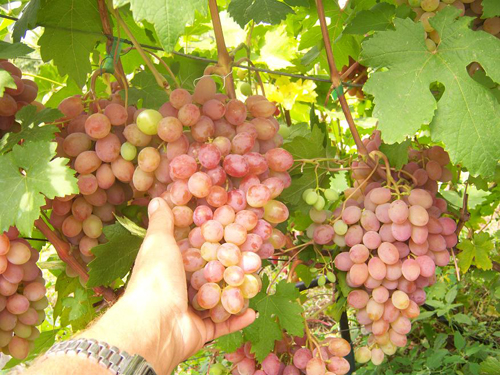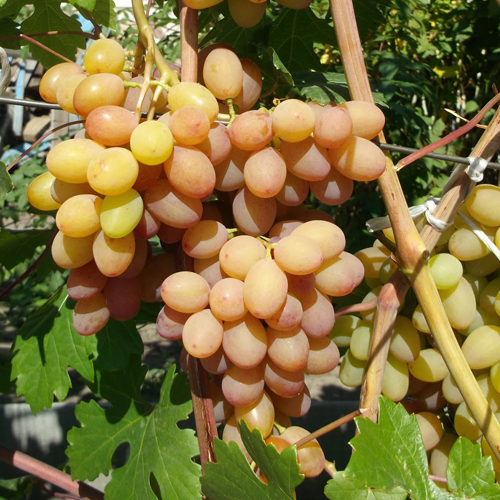Rumba grape variety
The numerous hybrid forms of amateur-bred grapes that have appeared in recent years often cannot boast of anything other than the unusual and impressive size of the bunches, with their varied and attractive colors. Otherwise, many of them show themselves as typical “average peasants”, not distinguished by either significant sugar accumulation, or high disease resistance, or good frost resistance. Their cultivation, even in the southern regions, is often associated with significant labor and funds for sheltering vines in winter and fighting pests and diseases in summer. Therefore, it is especially pleasant to see sometimes exceptions to the rules, thanks to which stars light up in the sky of endless ampelographic diversity, demonstrating not only an outward ostentatious result, but also having the makings, if not of a complex-resistant variety, then at least close to a similar characteristic.

One of these few varieties of grapes is Rumba, the author of which was the Don people's breeder Vasily Ulyanovich Kapelyushny. For more than twenty years, in his peasant farm, he was engaged in the creation of new hybrids, brought them into the world during this time, more than a hundred, but Rumba, in terms of the sum of all characteristics, is undoubtedly one of the best creations of Vasily Ulyanovich. It was born quite recently, but in just a few years it fell in love with many winegrowers and significantly expanded the geography of its cultivation. The reason for this popularity lies in a whole complex of factors: early maturity, a large size of beautiful in appearance and very sweet bunches, increased resistance to the most harmful fungal diseases and frost. For such a truly comprehensive set of positive qualities, the new variety certainly owes its parents and the talent of the breeder who picked and crossed them. In this grape, both parental forms at once are distinguished by their unpretentiousness and increased resistance to unfavorable cultivation conditions, and therefore he had no choice but to show the same properties. His maternal form was a well-known native of VNIIViV im. ME AND. Potapenko - Red delight, and his father's - no less striking representative of the Moldovan selection - Charrel. From this international couple, a child was born, ready to break the stereotypes about the bias of amateur selection exclusively in the direction of continuous “marketability” and “marketability”.
Agrobiological characteristics
The plants are distinguished by good vigor of growth, form a strong skeleton and a large supply of perennial wood. Young shoots of Rumba are light green, as they mature, they first acquire a reddish and then brown color. The leaves of the variety have a very beautiful openwork shape, large, rounded, strongly cut, have five clearly outlined blades. The notches between the lobes are deep, they are both closed with a narrow elliptical gap, and open lyre-shaped with a narrow mouth and a rounded bottom. The petiolate notch is wide, vaulted with a flat or slightly pointed bottom. The teeth at the edges of the leaves are triangular or sawtooth, unequal in size, their base is of medium width, and the apices are barely noticeably rounded. The flowers of the grapes are bisexual, no tendency to pea is observed. The vine ripens well, and only overly long fattening shoots are satisfactory.

Rumba clusters are large, cylindrical-conical, rather dense, weighing an average of 700-900 grams. Larger specimens also grow, but some growers complain, on the contrary, that the brushes are not massive enough. The peculiarities of care are evident. The comb is long - up to 10 cm, very graceful in appearance, but at the same time quite strong. Berries are oval or ovoid, very large in size - up to 32 mm in length and 24 mm in diameter, weighing 8-10 grams or more, aligned in size.The color can vary - from pale pink to almost red, and even purple. The shade depends on the degree of illumination during the ripening process and the air temperature at this time. The pulp of the grapes is dense, fleshy-juicy, very sweet in taste - up to sugary, it also has a pleasant aroma. The juice is colorless, with a high sugar content (23 g / 100 ml) characteristic of many "Vostorg" offspring, and an acidity in the range of 5-6 grams / liter. The seeds are present in the berry, but they do not carry a strong deterioration in the tasting characteristics. The skin is strong, according to some estimates, even rough, does not lose astringency for a long time during the ripening of the berries, which can somewhat spoil the overall impression of the variety. But, thanks to the same fact, the bunches hang beautifully on the vine for a very long period of time, the grapes are not damaged at all by wasps and other pests, and also do not crack even after heavy rains. The surface of the skin is covered with a light layer of waxy coating.
The Rumba harvest is consumed fresh, used for making juices, compotes and even wine due to its high sugar accumulation. Large clusters with an attractive pale pink color are very popular with customers in the market. The harvested crop is perfectly stored in cool rooms and refrigerated chambers without reducing the taste and presentation, and also has excellent transportability.
Removable ripeness occurs very quickly in grapes - already 95-105 days after the awakening of plants. The sum of active temperatures required for the variety is also quite modest - 2100-2200 ° C. In the south, the harvest is ready for harvest at the end of July - beginning of August, and under favorable weather conditions, even the brushes on the stepchildren, which Rumba lays very abundantly, have time to ripen in the fall. In the northern regions, two harvests per season, of course, will not work, but the main one is quite capable of ripening even in the Moscow region and regions similar in climatic conditions.

The productivity of this hybrid form is decent, but it does not pretend to be a record for this parameter. It begins to bear fruit in the middle - usually in the third year it forms the so-called "signal" clusters, and gives the first true harvests starting from the fourth season. From an adult bush, about 8-10 kilograms of grapes are harvested, a larger volume is possible only with large formations. A feature of the variety is a rather low percentage of fruitful shoots, which is why its tendency to overload is insignificant. The only thing worth paying attention to is the need to thin out an excessive number of inflorescences on stepchildren (or to completely remove them where they still do not have time to ripen), which distract the plant's strength from preparing for winter. The frost resistance of the bushes is increased, they easily tolerate cold temperatures down to -24 ° C.
Agrotechnical features
From an economic point of view, Rumba looks more than worthy, demonstrating high indicators of unpretentiousness and resistance to unfavorable cultivation factors. It is a very plastic variety, it can grow in a variety of conditions, without making any special claims to the level of soil fertility, its mechanical composition, moisture supply, etc. Everywhere, with the exception of regions that are completely unsuitable for viticulture, it is ready to give stable high-quality yields.
Planting grape bushes in areas infected with phylloxera should be done with seedlings grafted onto stable rootstocks, since the hybrid is quite new, and has not yet been tested for resistance to this pest. In regions free from phylloxera, it can be propagated without problems by cuttings, which take root quite easily.Most fungal diseases, including such harmful ones as mildew, powdery mildew and gray rot, as well as pests of Rumba bunches, do not care, so the variety can be grown with minimal pesticide load, getting a truly environmentally friendly harvest. Preventive treatments against diseases are needed only at the beginning of the growing season - before and after flowering, while by the time the crop ripens, there will be no traces of the chemicals used.
Shelter of the vine from frost is necessary only in regions that are not traditional for viticulture. For southern conditions, the frost resistance of the hybrid is quite sufficient for cultivation in non-sheltered culture. The forms of bushes management are also chosen accordingly: for vigorous plants, a high-stem formation with a free arrangement of annual growth is preferable, but it is appropriate only where the grape bushes are not covered for the winter. In the northern cultivation zone, special covering formations are used to facilitate the removal of vines from the trellis and their warming in autumn.
Rumba pruning and load regulation should be carried out with certain specifics, ignoring which threatens to drastically reduce plant productivity, evidence and claims about which there are many among winegrowers disillusioned with the hybrid. To get a high yield from the bush, in the spring, when pruning, a significant load with eyes is made on it, up to 45-50 pieces, with a large number of buds per fruit arrow (8-12 pieces). This is done due to the inherent low fertility of the variety, in which up to half of the developed grape shoots are sterile. They are then removed during the green debris, retaining only the fruitful ones. At the same time, the bunches are thinned on them, leaving one, the strongest, for the escape.
In addition to debris, Rumba during green operations requires careful removal of stepsons due to a strong tendency to form them, as well as minting a one-year increment, especially when it is placed vertically. It is recommended to lighten the bunches during ripening, due to which it will be possible to slightly reduce the characteristic astringency of the peel of the berries. For the same purpose, it is possible not to harvest the grape bunches in the early stages, allowing them to hang a little, accumulating additional sugar and improving the overall tasting rating of the berries.
Summing up, it is worth recognizing Rumba as a fairly promising variety that can take its niche both in farms and in summer cottages. At the same time, like any other variety, it has its own characteristics, which, due to the young age of the novelty, have not yet been fully studied. Therefore, the task of each winegrower who cultivates it is not only to mechanically carry out the list of standard measures, but also to become, to a certain extent, a researcher, carrying out his own variety testing and noting the positive or negative reaction of plants to certain operations. Only in this way it is possible to achieve the realization of all those potentialities that the new hybrid undoubtedly carries.








